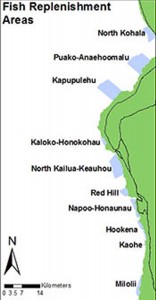 In 1998 the Hawai’i State legislature passed Act 306, which established the West Hawai’i Regional Fishery Management Area (WHRFMA) encompassing the near shore waters from Upolu Point (North Kohala) to Ka Lae (Southpoint in Ka’u) a shoreline distance of approximately 147 miles. The seaward boundary of the management area is marked by a water depth of 600 feet. This means that management strategies for this area will primarily effect near shore and reef fisheries. However, since pelagics such as rays and sharks are an essential factor in reef health, they are also included.
In 1998 the Hawai’i State legislature passed Act 306, which established the West Hawai’i Regional Fishery Management Area (WHRFMA) encompassing the near shore waters from Upolu Point (North Kohala) to Ka Lae (Southpoint in Ka’u) a shoreline distance of approximately 147 miles. The seaward boundary of the management area is marked by a water depth of 600 feet. This means that management strategies for this area will primarily effect near shore and reef fisheries. However, since pelagics such as rays and sharks are an essential factor in reef health, they are also included.
The overall purpose of Act 306 was to: Effectively manage fishery activities to ensure sustainability, enhance near shore resources and minimize conflicts of use in the WHRFMA. Act 306 also required that management decisions within the WHRFMA be made with substantial community involvement via facilitated dialogs with residents and resource users. To provide community involvement and input, the West Hawai′i Fisheries Council (WHFC) was formed in 1998 drawing on members and work of an antecedent group, the West Hawai′i Reef Fish Working Group. In order to accomplish the goals and tasks of the legislation, DLNR empowered the WHFC to serve as an advisory body and a primary source for formulating and recommending West Hawai′i management actions to DLNR.
The WHFC consists of stakeholders as well as additional non-voting, ex-officio resource people. The voting members represent a broad spectrum of community interest, user groups, and geographic locale. Ex-officio members have included UH Sea Grant, DAR, DOBOR, DOCARE, the Governor’s Liaison, Whale Sanctuary Representative, National Park Service and OHA. The WHFC strives to fairly represent the stake holder community and membership is open to all interested community members with knowledge and experience in the marine environment or issues concerning fishery management. As of June 2012 the WHFC has had over 50 different members contributing more than 3000 volunteer hours. At least 1800 community members have attended one or more WHFC meetings. Some of the accomplishments of the Council to date are:
- The WHFC established a network of ten Fish Replenishment Areas (FRAs) which prohibit aquarium fishing and fish feeding.
- The Council recommended amendments to the initial FRA rule to enhance enforcement and initiate the implementation of a sustainable, limited entry commercial aquarium fishery.
- The Council has worked with DLNR on the day-use mooring buoy program to site these buoys and inform communities of the value of such moorings to preserve our coral reefs.
- The Council developed rule amendments to provide limited kupuna harvesting of wana (sea urchins) within the Old Kona Airport Marine Life Conservation District (MLCD).
- The Council developed a set of gill net rule recommendations focused on limiting impacts of large-scale commercial netting while providing for subsistence netting. Six no- gill net refuges have been established as well as a Hawaiian cultural netting area (hand constructed, natural fiber nets only). The Council’s approach served as a subsequent model for state-wide gill net management.
- The WHFC Youth Council distributed a petition for no-smoking at Kahalu’u Beach Park, wrote a Resolution (with the help of Councilperson Virginia Isbell) and got it passed by the County Council and then wrote an ordinance that was passed unanimously. Kahalu’u Beach Park is now the second beach in the state that is no-smoking.
At the end of 2013, the Board of Land and Natural Resources approved and Governor Abercrombie signed a significant package of rule amendments that WHFC had been working on for ten years. These issues relate directly to the mandates of Act 306 (re-designated as HAR §13-60.4) to ensure sustainability, enhance near shore resources and minimize conflicts of use on West Hawai′i’s coral reefs. They are:
- Prohibition of SCUBA spearfishing within the WHRFMA
- Closure of an area fronting Ka′ohe (Pebble Beach), South Kona to aquarium collecting to reduce/eliminate longstanding user conflicts and resource concerns.
- Management of species of special concern. This includes eliminating the take of a number of vulnerable but ecologically and culturally important species and restricting aquarium harvesting to a limited number of species (40) which constitutes the vast majority (99%) of all fish species collected. In addition, size and/or bag limits for aquarium collectors are also proposed for three species (yellow tang, kole, and Achilles tang) which have been identified as important components of the aquarium fishery.
As noted, each of these efforts represents the culmination of many, many hours of community meetings and stakeholder input. For a detailed powerpoint presentation on the origins of the West Hawaii Fishery Council, please click here: Powerpoint by David Tarnas
